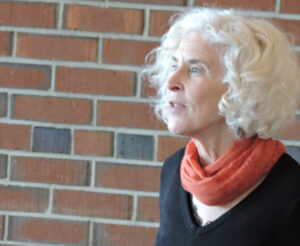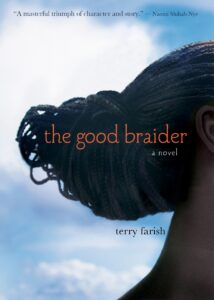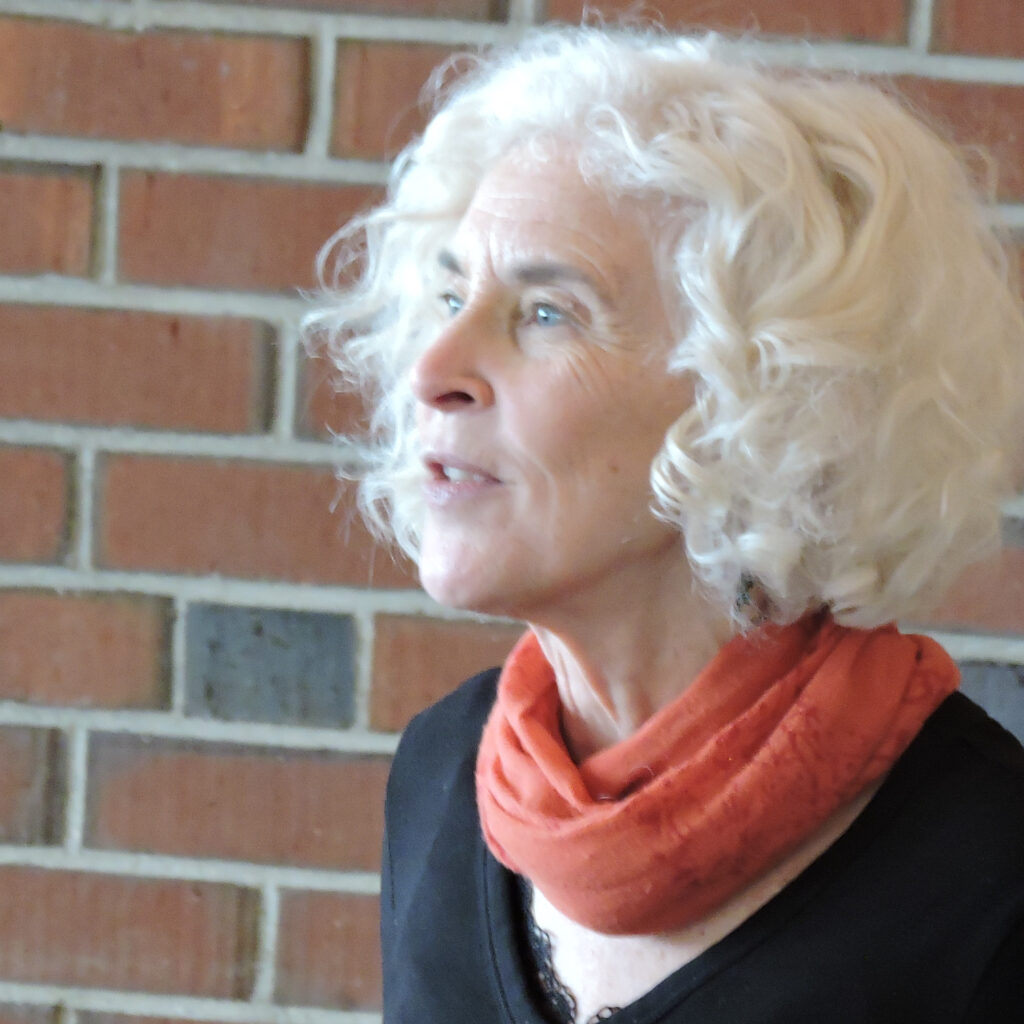A NH Writer’s Life – InDepthNH.org
Terry Farish – Literature is how I know the world.
By Beverly Stoddart

On a sunny October morning, I met Terry Farish at a perfect New Hampshire location. We sat at a rustic table on the deck of a cabin overlooking a stunning New Hampshire lake. Terry served freshly made blueberry muffins and delicious drip coffee with frothy heavy cream. We were there to talk about her career as a children’s author and to touch on some of her books. A favorite of mine is The Cat Who Liked Potato Soup. The book is about an “an ol’ Texas boy, country raised and don’t you know. He lived on a road called Chatterpie, just him and an uppity old cat who’d rather eat the old man’s potato soup than catch blackbirds.” Unfortunately, her editor rejected the first version of the book when she initially proposed it.
As the wife of a military man, Terry and her daughter, Elizabeth, went with him when he was transferred to England to live in the picturesque village of Oxfordshire, where she met and befriended the neighbor, Jimmy Fowler. Terry tells me of this hand-me-down tale that Jimmy shared with her one morning over coffee.
“Jimmy was an old man, and Elizabeth would go to school, and I would stop by, and he’d make me coffee, and he’d tell me stories. He knew about everybody in the village. He told me this story of when there was a man who lived there. He said I’ll tell you a story about a cat. He said there was an old-timer who had a cat, and they had just been together a long time, and he loved that cat. The cat was getting old. He was worried the cat was suffering. And he didn’t want this beloved cat to suffer. So one day, she didn’t get up. He needed to do something. There was a river down from our cottages called River Evenlode.” Terry pauses and says, “Jimmy’s telling this story, and he could be giving it a spiel, but I bought it all. He took the cat on his bicycle with a bag, and he put some stones in the bag. He put the cat in the bag with the stones because he couldn’t bear to see her suffer. He threw the bag into the river so the cat could have a peaceful death.”
Well, here is when I ask disturbed, dismayed, “He drowned the cat?”
“Yes,” Terry replies. “According to Jimmy. The man was very sad, and he peddled home and on his front stoop was the cat. She wasn’t dying at all. The editor I sent it to said this is a really good story, but we can’t publish a book where a man tries to drown his cat even if it ends up the way it does.” So, Terry switches it up and writes a book about an ol’ Texas boy and uppity cat, perfectly illustrated by Barry Root.
Terry writes in the book, “The cat was fond of the man’s potato soup which made him love her a breath more, but not so’s you’d notice.” As I read this line and looked at the soft, dreamy-like illustration, I thought that’s how much I want to love; a breath’s more.
Terry Farish is a petit, soft-spoken woman. And beneath this lovely exterior beats a courageous heart. An example of her courage was by spending a year in Vietnam – during the war.“
My father was transferred to Texas. There were so many military bases in Texas. So many soldiers were drafted. A lot of people were going to Vietnam, and we were near a helicopter base, where they learned and trained. I was in a women’s college, and we dated these helicopter pilot trainees, so Vietnam was a part of the now and the future. Someone came from the Red Cross to talk to the women at the university to recruit them to go to Vietnam to work for the Red Cross. I was reading all of the controversies about the war. I didn’t know the Vietnamese people’s point of view. So I thought I would like to go and work for the Red Cross. I was stationed in Cu Chi, not far from Saigon and the 25th Infantry. I was just out of college. Our job was to help the soldiers. This was a guerilla war. It was grim, and there was so much destruction of the people and American souls. The Red Cross hired young women to take recreation programs out to the men. We flew by chopper out to the fire support bases and the landing zones where the men were stationed. There were some stand-downs, maybe one or two in the year. Ours was a year tour, just like the soldiers and nurses. Some people never got over that year.”
I asked, “Were you ever in danger?”
“All the time! I was not injured. My mother was a patriot, and she, like a lot of military mothers, there was a pride your child would serve. Unfortunately, it took us too much after the war to reshift our minds. Once that veil is pulled away, you see how wars are always a political game. It’s kind of like a loss of innocence.”
Terry and my conversation move to her work of the books she’s written about people of color. In her 2016 book, Luis Paints the World, with illustrations by Oliver Dominguez, Terry tells the story of a young Dominican boy living in a Lawrence, Massachusetts neighborhood whose brother has left for another war, Afghanistan. Luis begins a mural on an alleyway wall where eventually the neighborhood families come to add their point-of-view to the drawing.
Another book from the same year is Joseph’s Big Ride, with illustrations by Ken Daley. Joseph is living in a refugee camp in South Sudan and immigrates to the United States. This book follows her 2012 book, The Good Braider, winner of the School Library Journal Best Book of the Year.
I ask, “Do you ever get any feedback on being a white woman writing in a world of people of color?”
“I do now. When I was writing these books and The Good Braider, identity politics had not taken hold so much that I do now. I’ve done two books in collaboration. I’ve learned how much I can do, how much more I can do with a collaborator. I wouldn’t write a book across cross-culture again from my point of view. It’s something that, as a writer, I’m just so hungry to discover new things. I love research and interviewing. I love understanding things so deeply that I can write about it. But politically, it’s not something that is honest anymore. And if I was going to write like the book I just did, The Boy from South Sudan, I want to write with someone who can take me deeply into the culture and then share the byline because we did it together. That’s what I want. Collaborating is now my favorite way to write. It feels it’s deeper than research. It’s sharing your lives with somebody else.”
“How did you get involved with the Portland Sudanese community?”
“It was 2001 when I met so many people from Sudan, and I was working in Portland, and began recording stories. I was a librarian at the Portland Public Library. Many of them said we would like you to tell our story because no one knows why we’re here. A lot of them didn’t have English. The kids did. I explained that I was writing about the experience of teenagers coming to this country for school. For about ten years, I worked with people there listening to stories. I was recording these stories. I was going to do a creative nonfiction book.”

“The Good Braider is a verse novel. Why did you write it in that form?”
“Fear. I was imagining Viola’s fear of her mother in that first scene, in the war. I didn’t want to write about Sudan. Everything I had read about it terrified me at the brutality and the loss. And when I was forced to write about it because I couldn’t make sense after what happened to me in Portland, unless I took her back into the war and imagined that for her, I thought I was writing nonfiction. As a lover of novels, I find more truth when something can be told in a deeply intimate way. I just put the research away and began to tell a story using all the information. The editor I worked with suggested an opening at the climax of the novel when her mother is angry with her for seeing a boy and taking it back into time back to the war.”
“In South Sudan, you had to find a way to get out because soldiers were all around you. How do you escape being killed by a patrol? Some were able to escape. Some went to a refugee camp, like Kakuma, and some went, like Viola’s family, to find a way to go to Khartoum. It was living in poverty, but if they kept going to Cairo, there was a chance they could become refugees.”
I ask Terry if she knew someone who has taken this journey of 1,730 miles the book recounts?
“A lot of the people I met. The fear was for the character because I was putting myself in her shoes. Your life had no value there. So when I began to write, I began to cut the sentences short. It was kind of like taking a breath. I kept going with these short lines and just broke the space there, and it seemed to be a way to catch my breath as I was writing and then imagining Viola trying to catch her breath. She was living it, and then I just kept going with those lines, and it seemed to be a way the story could be told by having lots of room to breathe to read slowly through this and let each line have all the import that it could bear.”
Terry talks about how immigration affected these new members of the Portland community. “Some of the elders said we didn’t know it would be like this in this country. We didn’t know that we would live separately from our families. We didn’t know our children would leave us. And that it was like a war here between generations. It completely broke families apart to leave the cultural tightness of families even though they were in a war. At least they knew roles, and coming to the US, took away the family structure. That’s been painful for the families, particularly the elders. This is probably the story of the first-generation immigrant. They all haven’t come out of the war, which deepens this impact. It’s an immigrant story.”
“Why are braids so important?”
“When I was with the teenagers and the adults and the females, particularly the teenagers, I was mostly recording stories of the teenage girls they were always working on the extensions of another one’s hair because it takes so long to braid the extensions. A little tiny, tiny part of the hair, and so each part has an extension woven into it. It takes a lot of time to put them in, and it takes a long time to take them out. You have to let your hair breathe, and it was so much of the part of how they engaged as friends. And they were telling stories. Even in school, when they were preparing for a dance festival, between dances braiding extensions into each other’s hair.”
“It determined for them who they were. It was about identity. It was like I have value. It was also a basic role within their family and community, and there was beauty. It was art. They did beautiful braids.”











